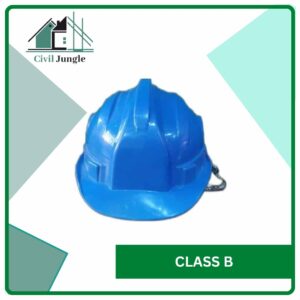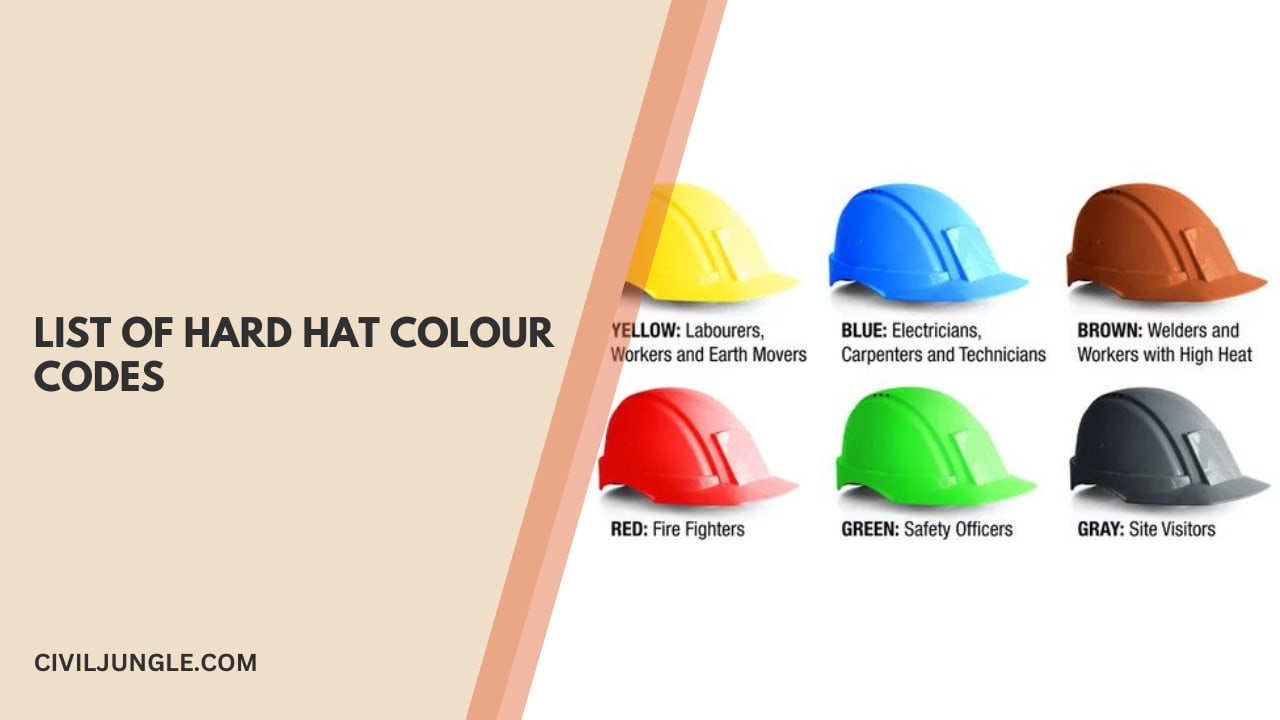
What Is Hard Hat?

Hard hats are one of the most important and essential accessories which are widely used on construction sites all over the world.
Hard hats are designed in such a way that it will help to protect the head of the worker from any kind of injury. Construction sites are usually prone to various accidents which may cause huge damage to the workers. In this article, you will get to know the hard hat colour meaning and the different types of Hard hat colour code used.
Hard Hat Colour Definition

A hard hat is defined as the helmet which is mainly used for safety purposes in the work environment such as industrial or construction sites to protect workmen from any kind of injury due to falling of objects and impact with objects, debris, and electric shock. It is also popularly known as a safety hat.
Advantages of Hard Hats on the Construction Sites

- The hard hat is very essential to ensure the safety of the workmen working on the site.
- It helps to protect the head of workmen from injuries.
- Safety helmets help in the protection of the human brain.
- The hard hat makes the work environment safe and secure.
- The hard hat colour code helps to understand the responsibility of the person in a particular working area.
- This will help the supervisors and managers to easily identify the group of workers working on a specific site.
Types of Safety Helmets / Hard Hats

A safety helmet is also known as Hard hat or headgear which are made up of different types of materials and designed in such way that it should protect the workmen head not only from the impact but also from flying particles and electric shocks etc.
Some of the special types of hard hats and also come with welding mask are a special type of screen on the helmet which will protect the face of workmen.
Safety helmets are classified into two types
- Full brimmed type helmet
- Brimless with peak
Classification of Hard Hats

The hard hats are classified into mainly four classes
- Class A
- Class B
- Class C
- Class D
Class A- Limited Voltage Resistance for General Services

- Class A safety helmets are High Voltage resistance and had limited resistance for general services.
- This kind of hard hat provides impact and penetration resistance with voltage protection. It provides voltage protection up to 2200 volts.
- Class A helmet shells are water resistance and slow-burning.
- Class A safety helmets should have water absorption of the shell after 24 hours immersion test should not be more than 5%.
- Class A safety helmets should be tested up to 2.2 kV for a time period of 3 minutes with leakage currents. It should not exist 9 mA.
Class B-High Voltage Resistance

- Class B safety helmets provide the highest level of protection against the various electrical hazards and shocks and burn protection.
- Class B safety helmets should be water-resistant and slow-burning.
- Class B safety helmets also provide good protection from impact and penetration hazards by falling objects.
Class C- No Voltage Protection

- Class C safety helmets are also known as metallic helmets or bump cap.
- It is designed in such a way that it will use in areas with low head clearance.
- Classic C helmets are not designed to protect against falling objects or electrical hazards.
- Class C safety helmets are generally recommended for Areas where protection is needed from head bumps.
Class D-Protection for Fire Fighting

- Class D safety helmet is fire resistant and non-conductor of electricity.
- Class D safety helmets are specially designed for fire fighting.
- The water absorption of class D safety helmets should not be more than 5%.
Different Hard Hat Colour Codes

There are specific standard hard hat colour codes that are pre-defined for the safety helmet based on the nature of the work ok are the responsibility of the job on the particular site.
List of Hard Hat Colour Codes

Different types of Hard hat colour codes are as follows.
- White Hard Hat
- Yellow Hard Hat
- Blue Hard Hat
- Green Hard Hat
- Red Hard Hat
- Grey Hard Hat
- Brown Hard Hat
- Orange Hard Hat
- Pink Hard Hats
1. White Hard Hat

White hard hat colour is generally used by the site managers engineers for men for supervisors on the site.
2. Yellow Hard Hat

The yellow hard hat colour is generally used by the labours and earthmoving operators. A yellow hard hat is usually preferred for the workers who operate heavy machinery on the construction site.
3. Blue Hard Hat

The blue hard hat colour is generally used by the technical operators which include electricians. Blue hard hat is also used by the carpenters and interim workers and technical Advisors on the site.
4. Green Hard Hat

Green hard hats are used by the safety team and the safety inspector but it can also be used by the new workers on the site are the trainee staff. The green hard hat colour code is also preferred for new hires and trainees.
5. Red Hard Hat

A red hard hat is usually worn by the Fire Marshal and firefighters.
6. Grey Hard Hat

The grey hard hat is generally used by the visitors on site.
7. Brown Hard Hat

The Brown hard hats are used by the builders and the workers with high heat applications.
8. Orange Hard Hat

The orange hard hat has high visibility so that it is generally used for the workers in the road and highway Constructions.
9. Pink Hard Hat

The pink hard hat colour code is most popular in the case of the female workers in many construction sites the pink colour hard hat is used by the workers who forget their helmet at home.
Note:
It is very essential and important for the companies to provide a hard hat for their workers to ensure safety. The safety helmet helps to run the working process smoothly and fast. It is also necessary to choose the best quality safety helmet which is made from high-quality materials.
The main purpose of using safety helmets is to protect from any falling object. If the safety elements are of not good quality then it will not help to protect workers. So it is very necessary to choose the best quality safety helmet.
Frequently asked questions (FAQs) that you can include in your article about hard hats:
What is a hard hat, and why is it important on construction sites?
A hard hat is a type of helmet designed to protect the wearer’s head from impacts, falling objects, and electrical hazards on construction sites. It is essential for preventing serious head injuries.
What do the different colors of hard hats signify?
Hard hat colors often indicate different roles or responsibilities on a construction site. For example, white might signify supervisors or managers, yellow for general laborers, and so on. These color codes help in identifying personnel quickly.
What are the different types of hard hats available?
Hard hats come in various types, such as full-brimmed or brimless with peaks. They are classified into different classes (A, B, C, D) based on their protective properties, including resistance to electrical hazards and impacts.
How should I choose the right hard hat for my job?
Choosing the right hard hat involves considering factors like the level of protection needed (electrical resistance, impact resistance), comfort, and fit. It’s crucial to select a hard hat that meets the safety standards relevant to your work environment.
What safety standards should hard hats meet?
Hard hats should meet specific safety standards set by regulatory bodies like OSHA (Occupational Safety and Health Administration) in the United States or equivalent standards in other countries. These standards ensure the helmet’s effectiveness in protecting against common workplace hazards.
Can hard hats protect against all types of injuries?
While hard hats provide crucial protection against head injuries caused by falling objects and impacts, they may not protect against all types of injuries, such as those caused by falls from heights or crushing injuries. Workers should use additional personal protective equipment as needed.
How often should hard hats be inspected and replaced?
Hard hats should be inspected regularly for signs of damage, such as cracks, dents, or deterioration. They should be replaced if they show signs of damage or if they have been subjected to a significant impact. Regular inspections ensure that the hard hat remains effective in protecting the wearer.
Are there special considerations for wearing hard hats in different weather conditions?
Yes, extreme temperatures can affect the performance of hard hats. For example, extreme heat can cause the material to degrade, while extreme cold can make the hard hat less flexible and more prone to cracking. It’s important to choose hard hats suitable for the environmental conditions of the work site.
What should I do if my hard hat is damaged?
If your hard hat is damaged, it should be replaced immediately. Using a damaged hard hat compromises your safety. Employers should provide a replacement promptly to ensure continuous protection for workers.
Are there regulations regarding the use of hard hats on construction sites?
Yes, construction sites are required to adhere to specific safety regulations regarding the use of personal protective equipment, including hard hats. These regulations aim to reduce the risk of workplace injuries and ensure a safe working environment for all personnel.

